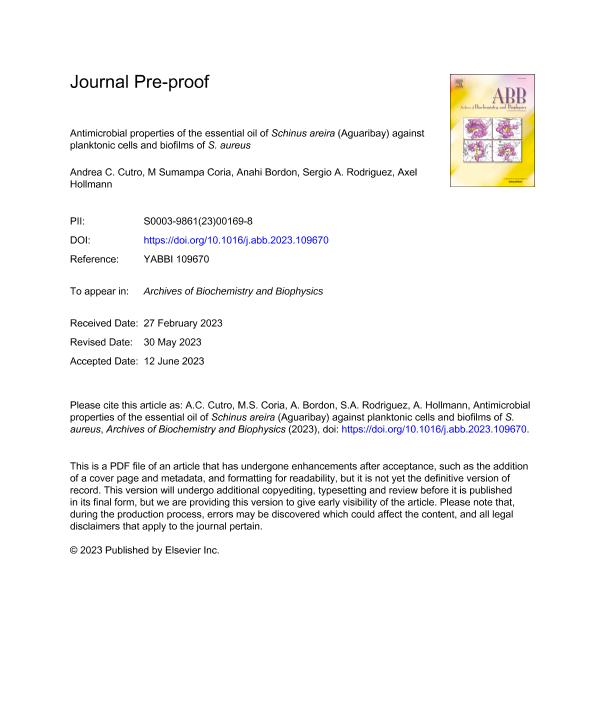Mostrar el registro sencillo del ítem
dc.contributor.author
Cutró, Andrea Carmen

dc.contributor.author
Coria, Maria Sumampa

dc.contributor.author
Bordón, Anahí

dc.contributor.author
Rodríguez, Sergio Antonio

dc.contributor.author
Hollmann, Axel

dc.date.available
2024-01-23T15:51:36Z
dc.date.issued
2023-08
dc.identifier.citation
Cutró, Andrea Carmen; Coria, Maria Sumampa; Bordón, Anahí; Rodríguez, Sergio Antonio; Hollmann, Axel; Antimicrobial properties of the essential oil of Schinus areira (Aguaribay) against planktonic cells and biofilms of S. aureus; Elsevier Science Inc.; Archives of Biochemistry and Biophysics; 744; 8-2023; 1-9
dc.identifier.issn
0003-9861
dc.identifier.uri
http://hdl.handle.net/11336/224638
dc.description.abstract
The essential oil (EO) of Schinus areira L. (Anacardiaceae) leaves has shown antibacterial activity against Staphylococcus aureus. In this study, we aimed to unravel the mechanisms of its antibacterial action by using bacterial cells and model membranes. First, the integrity of the S. aureus membrane was evaluated by fluorescence microscopy. It was observed that there was an increase in the permeability of cells that was dependent on the EO concentration as well as the incubation time. For a deep comprension of the action of the EO on the lipids, its effect on the membrane fluidity was evaluated on DMPC (1,2-dimyristoyl-sn-glycero-3-phosphocholine): DMPG (1,2-dimyristoyl-sn-glycero-3-phospho-1′-rac-glycerol) (5:1) liposomes by dynamic light scattering and by using Laurdan doped liposomes. The results indicate that EO produces changes in lipid membrane packing, increasing the fluidity, reducing the cooperative cohesive interaction between phospholipids and increasing access of water or the insertion of some components of the EO to the interior of the membrane. In addition, the potential effect of EO on intracellular targets, such as the increase of cytosolic reactive oxygen species (ROS) and DNA damage, were analyzed. The EO was capable of increasing the production of ROS as well as inducing a partial DNA degradation. Finally, the effect of EO on S. aureus biofilm was tested. These assays showed that EO was able to inhibit the biofilm formation, and also eradicate preformed biofilms. The results show, that the EO seems to have several bacterial targets involved in its antibacterial activity, from the bacterial membrane to DNA. Furthermore, the antibacterial action affects not only planktonic cells but also biofilms; reinforcing the potential application of this EO.
dc.format
application/pdf
dc.language.iso
eng
dc.publisher
Elsevier Science Inc.

dc.rights
info:eu-repo/semantics/openAccess
dc.rights.uri
https://creativecommons.org/licenses/by-nc-sa/2.5/ar/
dc.subject
BACTERIAL MEMBRANE
dc.subject
BIOFILM
dc.subject
MEMBRANE PERMEABILIZATION
dc.subject
NATURAL COMPOUNDS
dc.subject
ROS
dc.subject.classification
Biofísica

dc.subject.classification
Ciencias Biológicas

dc.subject.classification
CIENCIAS NATURALES Y EXACTAS

dc.title
Antimicrobial properties of the essential oil of Schinus areira (Aguaribay) against planktonic cells and biofilms of S. aureus
dc.type
info:eu-repo/semantics/article
dc.type
info:ar-repo/semantics/artículo
dc.type
info:eu-repo/semantics/publishedVersion
dc.date.updated
2024-01-18T15:06:54Z
dc.journal.volume
744
dc.journal.pagination
1-9
dc.journal.pais
Países Bajos

dc.journal.ciudad
Amsterdam
dc.description.fil
Fil: Cutró, Andrea Carmen. Consejo Nacional de Investigaciones Científicas y Técnicas. Centro Científico Tecnológico Conicet Noa Sur. Centro de Investigación en Biofísica Aplicada y Alimentos. - Universidad Nacional de Santiago del Estero. Centro de Investigación en Biofísica Aplicada y Alimentos; Argentina. Universidad Nacional de Santiago del Estero. Facultad de Ciencias Médicas; Argentina
dc.description.fil
Fil: Coria, Maria Sumampa. Universidad Nacional de Santiago del Estero. Instituto de Bionanotecnología del Noa. Consejo Nacional de Investigaciones Científicas y Técnicas. Centro Científico Tecnológico Conicet - Tucumán. Instituto de Bionanotecnología del Noa; Argentina. Universidad Nacional de Santiago del Estero. Facultad de Agronomía y Agroindustrias; Argentina
dc.description.fil
Fil: Bordón, Anahí. Consejo Nacional de Investigaciones Científicas y Técnicas. Centro Científico Tecnológico Conicet Noa Sur. Centro de Investigación en Biofísica Aplicada y Alimentos. - Universidad Nacional de Santiago del Estero. Centro de Investigación en Biofísica Aplicada y Alimentos; Argentina
dc.description.fil
Fil: Rodríguez, Sergio Antonio. Consejo Nacional de Investigaciones Científicas y Técnicas; Argentina. Universidad Nacional de Santiago del Estero. Facultad de Agronomía y Agroindustrias; Argentina
dc.description.fil
Fil: Hollmann, Axel. Consejo Nacional de Investigaciones Científicas y Técnicas. Centro Científico Tecnológico Conicet Noa Sur. Centro de Investigación en Biofísica Aplicada y Alimentos. - Universidad Nacional de Santiago del Estero. Centro de Investigación en Biofísica Aplicada y Alimentos; Argentina. Universidad Nacional de Quilmes. Departamento de Ciencia y Tecnología. Laboratorio de Microbiología Molecular; Argentina
dc.journal.title
Archives of Biochemistry and Biophysics

dc.relation.alternativeid
info:eu-repo/semantics/altIdentifier/url/https://linkinghub.elsevier.com/retrieve/pii/S0003986123001698
dc.relation.alternativeid
info:eu-repo/semantics/altIdentifier/doi/http://dx.doi.org/10.1016/j.abb.2023.109670
Archivos asociados
